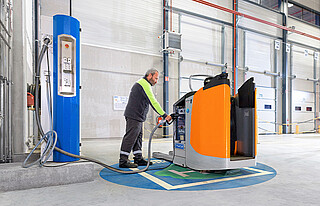Hydrogen in intralogistics
Hydrogen-based drives are the next logical step towards more sustainable intralogistics fleets. Expert Dyrk Draenkow explains which customers are interested in fuel cell technology - and what kind of expertise STILL already has in this area.

"At STILL, we recognised the potential of hydrogen for intralogistics at an early stage and have been working on feasibility studies in various projects since 2003," explains Dyrk Draenkow, Senior Product Manager Energy Systems. The potential of this gas is clear: in contrast to fossil fuels, the use of hydrogen in fuel cell systems produces only three products - energy, heat and water or water vapour. So instead of causing harmful CO2 emissions, the chemical reaction between hydrogen and atmospheric oxygen leaves only a small amount of water or water vapour, which can be easily released into the environment. "For a long time, hydrogen was considered only a purely technical gas. But that is starting to change and hydrogen is increasingly being seen as a fuel," says Draenkow. The idea that you can get green hydrogen like petrol at the filling station is still relatively new - but the next step is already clear. Hydrogen has great potential, especially compared to batteries: it can store energy easily and almost regardless of temperature, it is easy to transport and it is almost unlimited in its availability. That is why it is now being traded globally as a solution for many applications.
Pilot project: Europe's largest fuel cell fleet
The development of fuel cell systems has opened up new possibilities for hydrogen-based propulsion of vehicles. The fuel cell uses the chemical reaction between hydrogen and atmospheric oxygen to generate electrical energy, which in turn drives the vehicle's electric motor. However, fuel cell systems require space in the vehicle and a minimum number of operating hours to be economically viable. Converting to a hydrogen-based drive is therefore particularly worthwhile for larger fleets and vehicles that are used in two or three shifts. "It is also worthwhile for large contract logistics companies or car manufacturers with more than 1,500 operating hours per year to use this technology," says Draenkow. Thanks to the fuel cell systems, the vehicles are consistently powerful and achieve high peak performance. With the fuel cell system, it is no longer necessary to change batteries or park the vehicles for longer periods of time to recharge - instead, it only takes a few minutes to refuel at the hydrogen dispensers.
At the Carrefour distribution centre in Vendin, France, the conditions for converting to fuel cells were ideal: in multi-shift operation, full and mixed pallets of goods are picked every day for onward transport to around 360 Carrefour stores. "The conditions for the pilot project were very good," reports Draenkow. "STILL industrial trucks with fuel cell systems have already been in use at Carrefour since 2017." The total of 137 STILL trucks with hydrogen-based drive systems is currently the largest fuel cell fleet in Europe - and saves 300,000 kWh of electricity and 20 tonnes of CO2 every year.

Necessary infrastructure development
But even fuel cell technology has its limits: "In smaller, manually operated equipment, hydrogen-based systems are not a viable option - there we rely on our lithium-ion batteries," explains Draenkow. He also tends to advise customers with smaller fleets that run less than 1,500 operating hours per year to use electric forklift trucks and Smart Charging : "It's still very expensive to provide a customised hydrogen infrastructure to bring hydrogen into the warehouse." Although 'green' hydrogen is a promising fuel, it is not yet available in Germany in sufficient quantities at reasonable prices. "Most of the energy produced by wind, hydro and solar power is fed into the electricity grid," says Draenkow. There is not much left over for 'green' hydrogen production: "As with natural gas, we are dependent on imports here." This, however, requires the right infrastructure first: pipelines have to be laid and filling stations built.
A challenge for intralogistics: "A mixed fleet of about 80 industrial trucks needs about as much hydrogen per day as a single hydrogen truck," explains Draenkow. "These are such small quantities that it is not worthwhile laying pipelines specifically for intralogistics applications." Rather, warehouse logistics is dependent on other sectors or the so-called sector coupling: "In the future, there will be a hydrogen supply in heavy goods vehicles anyway," Draenkow continues. Large quantities of hydrogen will soon be needed at industrial hubs as well. For warehouses located at such hubs, conversion is therefore a real option.
Production of the 24-volt fuel cell launched
"At STILL, we have decided to bring the fuel cell expertise in-house," says Draenkow. STILL has therefore been producing its own 24-volt fuel cell system in Hamburg since 2023. In order to be able to offer customers comprehensive support in these matters, STILL has entered into a partnership with Hydrogentle GmbH. The Hamburg-based engineering company advises customers on the hydrogen infrastructure, while STILL provides the appropriate vehicles with fuel cell technology.
"Projects like the Carrefour distribution centre clearly show that it is worthwhile to think about switching to hydrogen-powered vehicles," says Draenkow. Especially where a hydrogen infrastructure already exists or the new fuel can be purchased in large quantities. "Also, if other parts of a site's infrastructure are being converted to hydrogen anyway, it makes sense to equip the industrial trucks with fuel cells as well," he adds. For a rapid ramp-up of the technology the cost of hydrogen will have to drop significantly before it can be used on a large scale. At present, a kilogram of green hydrogen costs about 13 euros. "At a price of two to three euros per kilogram, it will become a real alternative," estimates Draenkow. As the infrastructure expands and the availability of green hydrogen increases, the price should fall in the long term. And then STILL will be ready - with the right fuel technology and competent partners for the hydrogen infrastructure.
Contact request
Subscribe to the Newsletter !
Always up to date with STILL: Subscribe to the STILL newsletter and we will inform you regularly about interesting industry topics.
